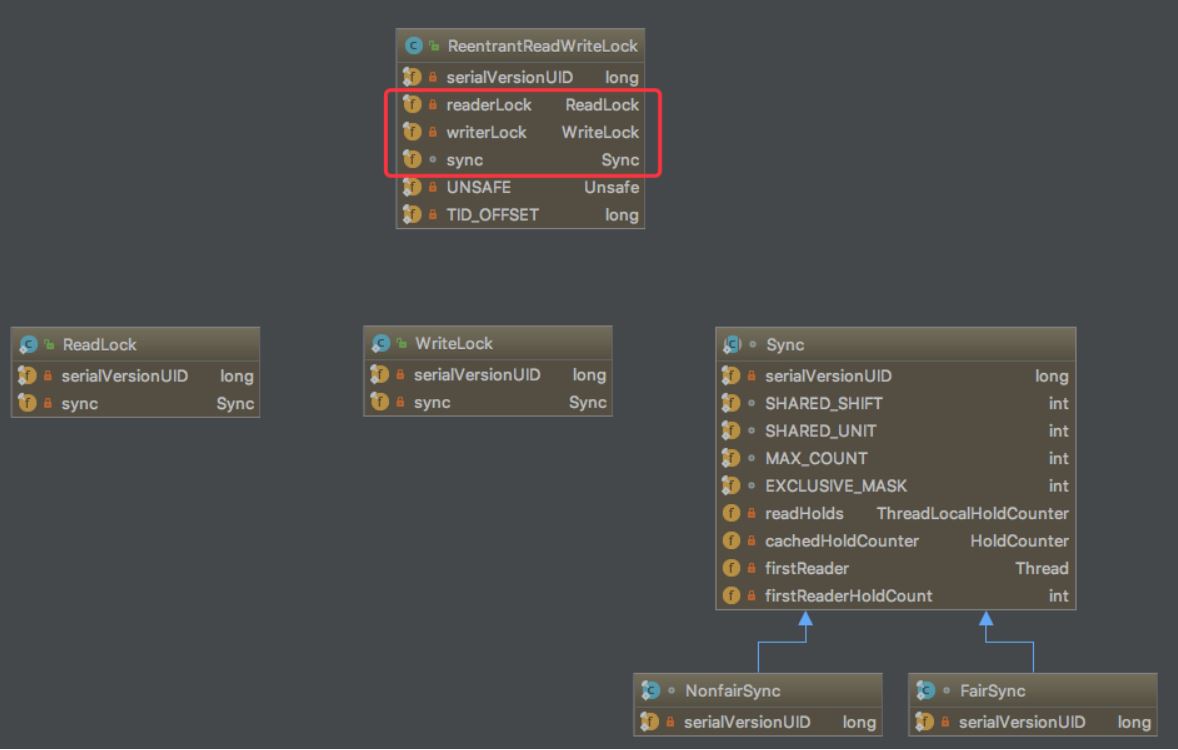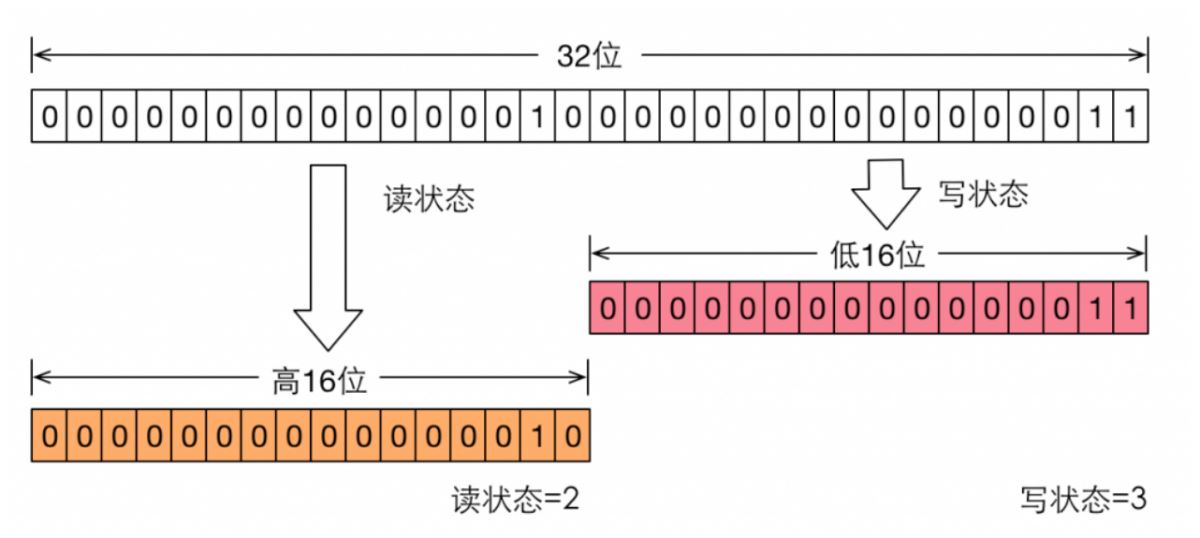- ubuntu12.04环境下使用kvm ioctl接口实现最简单的虚拟机
- Ubuntu 通过无线网络安装Ubuntu Server启动系统后连接无线网络的方法
- 在Ubuntu上搭建网桥的方法
- ubuntu 虚拟机上网方式及相关配置详解
CFSDN坚持开源创造价值,我们致力于搭建一个资源共享平台,让每一个IT人在这里找到属于你的精彩世界.
这篇CFSDN的博客文章Java 读写锁实现原理浅析由作者收集整理,如果你对这篇文章有兴趣,记得点赞哟.
最近做的一个小项目中有这样的需求:整个项目有一份config.json保存着项目的一些配置,是存储在本地文件的一个资源,并且应用中存在读写(读>>写)更新问题。既然读写并发操作,那么就涉及到操作互斥,这里自然想到了读写锁,本文对读写锁方面的知识做个梳理.
为什么需要读写锁?
与传统锁不同的是读写锁的规则是可以共享读,但只能一个写,总结起来为:读读不互斥,读写互斥,写写互斥,而一般的独占锁是:读读互斥,读写互斥,写写互斥,而场景中往往读远远大于写,读写锁就是为了这种优化而创建出来的一种机制.
注意是读远远大于写,一般情况下独占锁的效率低来源于高并发下对临界区的激烈竞争导致线程上下文切换。因此当并发不是很高的情况下,读写锁由于需要额外维护读锁的状态,可能还不如独占锁的效率高。因此需要根据实际情况选择使用.
一个简单的读写锁实现 。
根据上面理论可以利用两个int变量来简单实现一个读写锁,实现虽然烂,但是原理都是差不多的,值得阅读下.
|
1
2
3
4
5
6
7
8
9
10
11
12
13
14
15
16
17
18
19
20
21
22
23
24
25
26
27
28
29
30
31
32
33
34
35
36
37
38
39
40
41
42
43
44
45
46
47
48
49
|
public
class
readwritelock {
/**
* 读锁持有个数
*/
private
int
readcount =
0
;
/**
* 写锁持有个数
*/
private
int
writecount =
0
;
/**
* 获取读锁,读锁在写锁不存在的时候才能获取
*/
public
synchronized
void
lockread()
throws
interruptedexception {
// 写锁存在,需要wait
while
(writecount >
0
) {
wait();
}
readcount++;
}
/**
* 释放读锁
*/
public
synchronized
void
unlockread() {
readcount--;
notifyall();
}
/**
* 获取写锁,当读锁存在时需要wait.
*/
public
synchronized
void
lockwrite()
throws
interruptedexception {
// 先判断是否有写请求
while
(writecount >
0
) {
wait();
}
// 此时已经不存在获取写锁的线程了,因此占坑,防止写锁饥饿
writecount++;
// 读锁为0时获取写锁
while
(readcount >
0
) {
wait();
}
}
/**
* 释放读锁
*/
public
synchronized
void
unlockwrite() {
writecount--;
notifyall();
}
}
|
readwritelock的实现原理 。
在java中readwritelock的主要实现为reentrantreadwritelock,其提供了以下特性:
reentrantreadwritelock的结构 。
reentrantreadwritelock的核心是由一个基于aqs的同步器sync构成,然后由其扩展出readlock(共享锁),writelock(排它锁)所组成.

并且从reentrantreadwritelock的构造函数中可以发现readlock与writelock使用的是同一个sync,具体怎么实现同一个队列既可以为共享锁,又可以表示排他锁下文会具体分析.
清单一:reentrantreadwritelock构造函数 。
|
1
2
3
4
5
|
public
reentrantreadwritelock(
boolean
fair) {
sync = fair ?
new
fairsync() :
new
nonfairsync();
readerlock =
new
readlock(
this
);
writerlock =
new
writelock(
this
);
}
|
sync的实现 。
sync是读写锁实现的核心,sync是基于aqs实现的,在aqs中核心是state字段和双端队列,那么一个一个问题来分析.
sync如何同时表示读锁与写锁?
清单2:读写锁状态获取 。
|
1
2
3
4
5
6
7
8
|
static
final
int
shared_shift =
16
;
static
final
int
shared_unit = (
1
<< shared_shift);
static
final
int
max_count = (
1
<< shared_shift) -
1
;
static
final
int
exclusive_mask = (
1
<< shared_shift) -
1
;
/** returns the number of shared holds represented in count */
static
int
sharedcount(
int
c) {
return
c >>> shared_shift; }
/** returns the number of exclusive holds represented in count */
static
int
exclusivecount(
int
c) {
return
c & exclusive_mask; }
|
从代码中获取读写状态可以看出其是把state(int32位)字段分成高16位与低16位,其中高16位表示读锁个数,低16位表示写锁个数,如下图所示(图来自java并发编程艺术).

该图表示当前一个线程获取到了写锁,并且重入了两次,因此低16位是3,并且该线程又获取了读锁,并且重入了一次,所以高16位是2,当写锁被获取时如果读锁不为0那么读锁一定是获取写锁的这个线程.
读锁的获取 。
读锁的获取主要实现是aqs中的acquireshared方法,其调用过程如下代码.
清单3:读锁获取入口 。
|
1
2
3
4
5
6
7
8
9
|
// readlock
public
void
lock() {
sync.acquireshared(
1
);
}
// aqs
public
final
void
acquireshared(
int
arg) {
if
(tryacquireshared(arg) <
0
)
doacquireshared(arg);
}
|
其中doacquireshared(arg)方法是获取失败之后aqs中入队操作,等待被唤醒后重新获取,那么关键点就是tryacquireshared(arg)方法,方法有点长,因此先总结出获取读锁所经历的步骤,获取的第一部分步骤如下:
清单4:读锁获取的第一部分 。
|
1
2
3
4
5
6
7
8
9
10
11
12
13
14
15
16
17
18
19
20
21
22
23
24
25
26
27
28
29
30
31
32
33
34
35
|
protected
final
int
tryacquireshared(
int
unused) {
thread current = thread.currentthread();
int
c = getstate();
// 操作1:存在写锁,并且写锁不是当前线程则直接去排队
if
(exclusivecount(c) !=
0
&&
getexclusiveownerthread() != current)
return
-
1
;
int
r = sharedcount(c);
// 操作2:读锁是否该阻塞,对于非公平模式下写锁获取优先级会高,如果存在要获取写锁的线程则读锁需要让步,公平模式下则先来先到
if
(!readershouldblock() &&
// 读锁使用高16位,因此存在获取上限为2^16-1
r < max_count &&
// 操作3:cas修改读锁状态,实际上是读锁状态+1
compareandsetstate(c, c + shared_unit)) {
// 操作4:执行到这里说明读锁已经获取成功,因此需要记录线程状态。
if
(r ==
0
) {
firstreader = current;
// firstreader是把读锁状态从0变成1的那个线程
firstreaderholdcount =
1
;
}
else
if
(firstreader == current) {
firstreaderholdcount++;
}
else
{
// 这些代码实际上是从threadlocal中获取当前线程重入读锁的次数,然后自增下。
holdcounter rh = cachedholdcounter;
// cachedholdcounter是上一个获取锁成功的线程
if
(rh ==
null
|| rh.tid != getthreadid(current))
cachedholdcounter = rh = readholds.get();
else
if
(rh.count ==
0
)
readholds.set(rh);
rh.count++;
}
return
1
;
}
// 当操作2,操作3失败时执行该逻辑
return
fulltryacquireshared(current);
}
|
当操作2,操作3失败时会执行fulltryacquireshared(current),为什么会这样写呢?个人认为是一种补偿操作,操作2与操作3失败并不代表当前线程没有读锁的资格,并且这里的读锁是共享锁,有资格就应该被获取成功,因此给予补偿获取读锁的操作。在fulltryacquireshared(current)中是一个循环获取读锁的过程,大致步骤如下:
清单5:读锁获取的第二部分 。
|
1
2
3
4
5
6
7
8
9
10
11
12
13
14
15
16
17
18
19
20
21
22
23
24
25
26
27
28
29
30
31
32
33
34
35
36
37
38
39
40
41
42
43
44
45
46
47
48
49
50
51
52
53
54
55
56
57
|
final
int
fulltryacquireshared(thread current) {
holdcounter rh =
null
;
// 最外层嵌套循环
for
(;;) {
int
c = getstate();
// 操作5:存在写锁,且写锁并非当前线程则直接返回失败
if
(exclusivecount(c) !=
0
) {
if
(getexclusiveownerthread() != current)
return
-
1
;
// else we hold the exclusive lock; blocking here
// would cause deadlock.
// 操作6:如果当前线程是重入读锁则放行
}
else
if
(readershouldblock()) {
// make sure we're not acquiring read lock reentrantly
// 当前是firstreader,则直接放行,说明是已获取的线程重入读锁
if
(firstreader == current) {
// assert firstreaderholdcount > 0;
}
else
{
// 执行到这里说明是其他线程,如果是cachedholdcounter(其count不为0)也就是上一个获取锁的线程则可以重入,否则进入aqs中排队
// **这里也是对写锁的让步**,如果队列中头结点为写锁,那么当前获取读锁的线程要进入队列中排队
if
(rh ==
null
) {
rh = cachedholdcounter;
if
(rh ==
null
|| rh.tid != getthreadid(current)) {
rh = readholds.get();
if
(rh.count ==
0
)
readholds.remove();
}
}
// 说明是上述刚初始化的rh,所以直接去aqs中排队
if
(rh.count ==
0
)
return
-
1
;
}
}
if
(sharedcount(c) == max_count)
throw
new
error(
"maximum lock count exceeded"
);
// 操作7:修改读锁状态,实际上读锁自增操作
if
(compareandsetstate(c, c + shared_unit)) {
// 操作8:对threadlocal中维护的获取锁次数进行更新。
if
(sharedcount(c) ==
0
) {
firstreader = current;
firstreaderholdcount =
1
;
}
else
if
(firstreader == current) {
firstreaderholdcount++;
}
else
{
if
(rh ==
null
)
rh = cachedholdcounter;
if
(rh ==
null
|| rh.tid != getthreadid(current))
rh = readholds.get();
else
if
(rh.count ==
0
)
readholds.set(rh);
rh.count++;
cachedholdcounter = rh;
// cache for release
}
return
1
;
}
}
}
|
读锁的释放 。
清单6:读锁释放入口 。
|
1
2
3
4
5
6
7
8
9
10
11
12
|
// readlock
public
void
unlock() {
sync.releaseshared(
1
);
}
// sync
public
final
boolean
releaseshared(
int
arg) {
if
(tryreleaseshared(arg)) {
doreleaseshared();
// 这里实际上是释放读锁后唤醒写锁的线程操作
return
true
;
}
return
false
;
}
|
读锁的释放主要是tryreleaseshared(arg)函数,因此拆解其步骤如下:
清单7:读锁的释放流程 。
|
1
2
3
4
5
6
7
8
9
10
11
12
13
14
15
16
17
18
19
20
21
22
23
24
25
26
27
28
29
30
31
32
33
|
protected
final
boolean
tryreleaseshared(
int
unused) {
thread current = thread.currentthread();
// 操作1:清理threadlocal对应的信息
if
(firstreader == current) {;
if
(firstreaderholdcount ==
1
)
firstreader =
null
;
else
firstreaderholdcount--;
}
else
{
holdcounter rh = cachedholdcounter;
if
(rh ==
null
|| rh.tid != getthreadid(current))
rh = readholds.get();
int
count = rh.count;
// 已释放完的读锁的线程清空操作
if
(count <=
1
) {
readholds.remove();
// 如果没有获取锁却释放则会报该错误
if
(count <=
0
)
throw
unmatchedunlockexception();
}
--rh.count;
}
// 操作2:循环中利用cas修改读锁状态
for
(;;) {
int
c = getstate();
int
nextc = c - shared_unit;
if
(compareandsetstate(c, nextc))
// releasing the read lock has no effect on readers,
// but it may allow waiting writers to proceed if
// both read and write locks are now free.
return
nextc ==
0
;
}
}
|
写锁的获取 。
清单8:写锁的获取入口 。
|
1
2
3
4
5
6
7
8
9
10
11
|
// writelock
public
void
lock() {
sync.acquire(
1
);
}
// aqs
public
final
void
acquire(
int
arg) {
// 尝试获取,获取失败后入队,入队失败则interrupt当前线程
if
(!tryacquire(arg) &&
acquirequeued(addwaiter(node.exclusive), arg))
selfinterrupt();
}
|
写锁的获取也主要是tryacquire(arg)方法,这里也拆解步骤:
清单9:写锁的获取 。
|
1
2
3
4
5
6
7
8
9
10
11
12
13
14
15
16
17
18
19
20
21
22
23
24
|
protected
final
boolean
tryacquire(
int
acquires) {
thread current = thread.currentthread();
int
c = getstate();
int
w = exclusivecount(c);
// 操作1:c != 0,说明存在读锁或者写锁
if
(c !=
0
) {
// (note: if c != 0 and w == 0 then shared count != 0)
// 写锁为0,读锁不为0 或者获取写锁的线程并不是当前线程,直接失败
if
(w ==
0
|| current != getexclusiveownerthread())
return
false
;
if
(w + exclusivecount(acquires) > max_count)
throw
new
error(
"maximum lock count exceeded"
);
// reentrant acquire
// 执行到这里说明是写锁线程的重入操作,直接修改状态,也不需要cas因为没有竞争
setstate(c + acquires);
return
true
;
}
// 操作2:获取写锁,writershouldblock对于非公平模式直接返回fasle,对于公平模式则线程需要排队,因此需要阻塞。
if
(writershouldblock() ||
!compareandsetstate(c, c + acquires))
return
false
;
setexclusiveownerthread(current);
return
true
;
}
|
写锁的释放 。
清单10:写锁的释放入口 。
|
1
2
3
4
5
6
7
8
9
10
11
12
13
14
15
|
// writelock
public
void
unlock() {
sync.release(
1
);
}
// aqs
public
final
boolean
release(
int
arg) {
// 释放锁成功后唤醒队列中第一个线程
if
(tryrelease(arg)) {
node h = head;
if
(h !=
null
&& h.waitstatus !=
0
)
unparksuccessor(h);
return
true
;
}
return
false
;
}
|
写锁的释放主要是tryrelease(arg)方法,其逻辑就比较简单了,注释很详细.
清单11:写锁的释放 。
|
1
2
3
4
5
6
7
8
9
10
11
12
13
14
|
protected
final
boolean
tryrelease(
int
releases) {
// 如果当前线程没有获取写锁却释放,则直接抛异常
if
(!isheldexclusively())
throw
new
illegalmonitorstateexception();
// 状态变更至nextc
int
nextc = getstate() - releases;
// 因为写锁是可以重入,所以在都释放完毕后要把独占标识清空
boolean
free = exclusivecount(nextc) ==
0
;
if
(free)
setexclusiveownerthread(
null
);
// 修改状态
setstate(nextc);
return
free;
}
|
一些其他问题 。
锁降级操作哪里体现?
锁降级操作指的是一个线程获取写锁之后再获取读锁,然后读锁释放掉写锁的过程。在tryacquireshared(arg)获取读锁的代码中有如下代码.
清单12:写锁降级策略 。
|
1
2
3
4
5
6
7
|
thread current = thread.currentthread();
// 当前状态
int
c = getstate();
// 存在写锁,并且写锁不等于当前线程时返回,换句话说等写锁为当前线程时则可以继续往下获取读锁。
if
(exclusivecount(c) !=
0
&&
getexclusiveownerthread() != current)
return
-
1
;
|
。。。。。读锁获取。。。。.
那么锁降级有什么用?答案是为了可见性的保证。在reentrantreadwritelock的javadoc中有如下代码,其是锁降级的一个应用示例.
|
1
2
3
4
5
6
7
8
9
10
11
12
13
14
15
16
17
18
19
20
21
22
23
24
25
26
27
28
29
30
31
32
33
34
35
36
37
|
class
cacheddata {
object data;
volatile
boolean
cachevalid;
final
reentrantreadwritelock rwl =
new
reentrantreadwritelock();
void
processcacheddata() {
// 获取读锁
rwl.readlock().lock();
if
(!cachevalid) {
// must release read lock before acquiring write lock,不释放的话下面写锁会获取不成功,造成死锁
rwl.readlock().unlock();
// 获取写锁
rwl.writelock().lock();
try
{
// recheck state because another thread might have
// acquired write lock and changed state before we did.
if
(!cachevalid) {
data = ...
cachevalid =
true
;
}
// downgrade by acquiring read lock before releasing write lock
// 这里再次获取读锁,如果不获取那么当写锁释放后可能其他写线程再次获得写锁,导致下方`use(data)`时出现不一致的现象
// 这个操作就是降级
rwl.readlock().lock();
}
finally
{
rwl.writelock().unlock();
// unlock write, still hold read
}
}
try
{
// 使用完后释放读锁
use(data);
}
finally
{
rwl.readlock().unlock();
}
}
}}
|
公平与非公平的区别 。
清单13:公平下的sync 。
|
1
2
3
4
5
6
7
8
9
|
static
final
class
fairsync
extends
sync {
private
static
final
long
serialversionuid = -2274990926593161451l;
final
boolean
writershouldblock() {
return
hasqueuedpredecessors();
// 队列中是否有元素,有责当前操作需要block
}
final
boolean
readershouldblock() {
return
hasqueuedpredecessors();
// 队列中是否有元素,有责当前操作需要block
}
}
|
公平下的sync实现策略是所有获取的读锁或者写锁的线程都需要入队排队,按照顺序依次去尝试获取锁.
清单14:非公平下的sync 。
|
1
2
3
4
5
6
7
8
9
10
11
12
13
14
15
16
17
18
|
static
final
class
nonfairsync
extends
sync {
private
static
final
long
serialversionuid = -8159625535654395037l;
final
boolean
writershouldblock() {
// 非公平下不考虑排队,因此写锁可以竞争获取
return
false
;
// writers can always barge
}
final
boolean
readershouldblock() {
/* as a heuristic to avoid indefinite writer starvation,
* block if the thread that momentarily appears to be head
* of queue, if one exists, is a waiting writer. this is
* only a probabilistic effect since a new reader will not
* block if there is a waiting writer behind other enabled
* readers that have not yet drained from the queue.
*/
// 这里实际上是一个优先级,如果队列中头部元素时写锁,那么读锁需要等待,避免写锁饥饿。
return
apparentlyfirstqueuedisexclusive();
}
}
|
非公平下由于抢占式获取锁,写锁是可能产生饥饿,因此解决办法就是提高写锁的优先级,换句话说获取写锁之前先占坑.
总结 。
以上所述是小编给大家介绍的java 读写锁实现原理浅析,希望对大家有所帮助,如果大家有任何疑问请给我留言,小编会及时回复大家的。在此也非常感谢大家对我网站的支持! 。
原文链接:https://my.oschina.net/editorial-story/blog/1928306 。
最后此篇关于Java 读写锁实现原理浅析的文章就讲到这里了,如果你想了解更多关于Java 读写锁实现原理浅析的内容请搜索CFSDN的文章或继续浏览相关文章,希望大家以后支持我的博客! 。
背景: 我最近一直在使用 JPA,我为相当大的关系数据库项目生成持久层的轻松程度给我留下了深刻的印象。 我们公司使用大量非 SQL 数据库,特别是面向列的数据库。我对可能对这些数据库使用 JPA 有一
我已经在我的 maven pom 中添加了这些构建配置,因为我希望将 Apache Solr 依赖项与 Jar 捆绑在一起。否则我得到了 SolarServerException: ClassNotF
interface ITurtle { void Fight(); void EatPizza(); } interface ILeonardo : ITurtle {
我希望可用于 Java 的对象/关系映射 (ORM) 工具之一能够满足这些要求: 使用 JPA 或 native SQL 查询获取大量行并将其作为实体对象返回。 允许在行(实体)中进行迭代,并在对当前
好像没有,因为我有实现From for 的代码, 我可以转换 A到 B与 .into() , 但同样的事情不适用于 Vec .into()一个Vec . 要么我搞砸了阻止实现派生的事情,要么这不应该发
在 C# 中,如果 A 实现 IX 并且 B 继承自 A ,是否必然遵循 B 实现 IX?如果是,是因为 LSP 吗?之间有什么区别吗: 1. Interface IX; Class A : IX;
就目前而言,这个问题不适合我们的问答形式。我们希望答案得到事实、引用资料或专业知识的支持,但这个问题可能会引发辩论、争论、投票或扩展讨论。如果您觉得这个问题可以改进并可能重新打开,visit the
我正在阅读标准haskell库的(^)的实现代码: (^) :: (Num a, Integral b) => a -> b -> a x0 ^ y0 | y0 a -> b ->a expo x0
我将把国际象棋游戏表示为 C++ 结构。我认为,最好的选择是树结构(因为在每个深度我们都有几个可能的移动)。 这是一个好的方法吗? struct TreeElement{ SomeMoveType
我正在为用户名数据库实现字符串匹配算法。我的方法采用现有的用户名数据库和用户想要的新用户名,然后检查用户名是否已被占用。如果采用该方法,则该方法应该返回带有数据库中未采用的数字的用户名。 例子: “贾
我正在尝试实现 Breadth-first search algorithm , 为了找到两个顶点之间的最短距离。我开发了一个 Queue 对象来保存和检索对象,并且我有一个二维数组来保存两个给定顶点
我目前正在 ika 中开发我的 Python 游戏,它使用 python 2.5 我决定为 AI 使用 A* 寻路。然而,我发现它对我的需要来说太慢了(3-4 个敌人可能会落后于游戏,但我想供应 4-
我正在寻找 Kademlia 的开源实现C/C++ 中的分布式哈希表。它必须是轻量级和跨平台的(win/linux/mac)。 它必须能够将信息发布到 DHT 并检索它。 最佳答案 OpenDHT是
我在一本书中读到这一行:-“当我们要求 C++ 实现运行程序时,它会通过调用此函数来实现。” 而且我想知道“C++ 实现”是什么意思或具体是什么。帮忙!? 最佳答案 “C++ 实现”是指编译器加上链接
我正在尝试使用分支定界的 C++ 实现这个背包问题。此网站上有一个 Java 版本:Implementing branch and bound for knapsack 我试图让我的 C++ 版本打印
在很多情况下,我需要在 C# 中访问合适的哈希算法,从重写 GetHashCode 到对数据执行快速比较/查找。 我发现 FNV 哈希是一种非常简单/好/快速的哈希算法。但是,我从未见过 C# 实现的
目录 LRU缓存替换策略 核心思想 不适用场景 算法基本实现 算法优化
1. 绪论 在前面文章中提到 空间直角坐标系相互转换 ,测绘坐标转换时,一般涉及到的情况是:两个直角坐标系的小角度转换。这个就是我们经常在测绘数据处理中,WGS-84坐标系、54北京坐标系
在软件开发过程中,有时候我们需要定时地检查数据库中的数据,并在发现新增数据时触发一个动作。为了实现这个需求,我们在 .Net 7 下进行一次简单的演示. PeriodicTimer .
二分查找 二分查找算法,说白了就是在有序的数组里面给予一个存在数组里面的值key,然后将其先和数组中间的比较,如果key大于中间值,进行下一次mid后面的比较,直到找到相等的,就可以得到它的位置。

我是一名优秀的程序员,十分优秀!